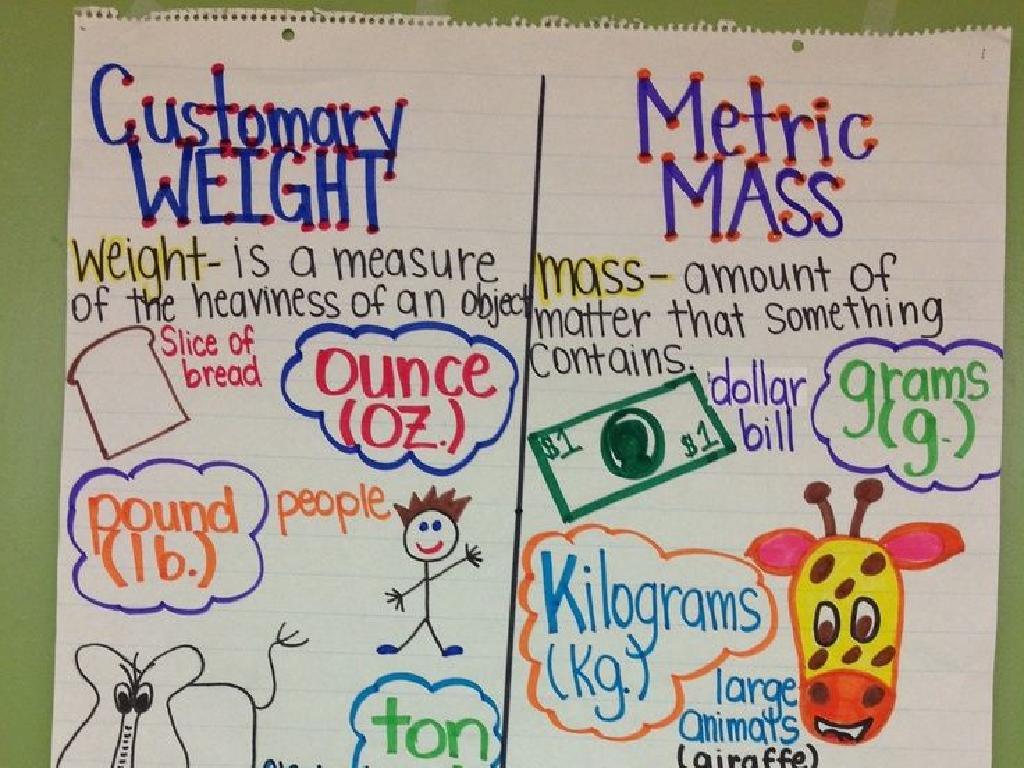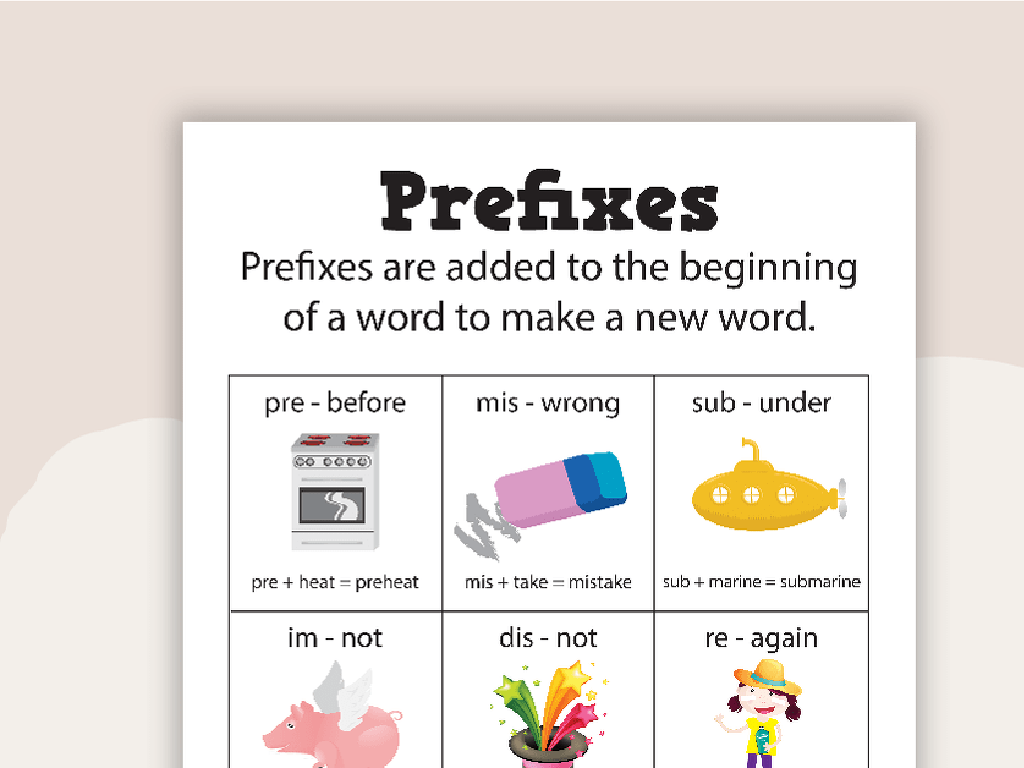Word Pattern Analogies
Subject: Language arts
Grade: Fifth grade
Topic: Prefixes And Suffixes
Please LOG IN to download the presentation. Access is available to registered users only.
View More Content
Exploring Prefixes and Suffixes
– Discover word pattern analogies
– Prefixes: Beginning of words
– ‘Un-‘ in ‘unhappy’ means ‘not’, changing the meaning.
– Suffixes: Endings that modify
– ‘Ful’ in ‘hopeful’ means ‘full of’, altering the word.
– Impact on word meanings
|
This slide introduces students to the concept of word pattern analogies, focusing on how prefixes and suffixes alter the meanings of base words. Begin by explaining that a prefix is a group of letters added to the beginning of a word to change its meaning, such as ‘un-‘ in ‘unhappy’ which changes the meaning to ‘not happy’. Similarly, a suffix is a group of letters added to the end of a word that modifies its meaning, like ‘ful’ in ‘hopeful’ meaning ‘full of hope’. Discuss how understanding these patterns can help decipher unfamiliar words. Engage the class with examples and encourage them to think of additional words that follow these patterns.
Exploring Prefixes
– Prefixes: Beginning word parts
– Prefixes modify word meaning
– Example: ‘un-‘ means not
– ‘unhappy’ means not happy
– Example: ‘re-‘ means again
– ‘redo’ means to do again
|
This slide introduces the concept of prefixes to the students. Prefixes are groups of letters placed before the start of a word to alter its meaning. For instance, adding ‘un-‘ to ‘happy’ changes the meaning to ‘not happy,’ and adding ‘re-‘ to ‘do’ changes the meaning to ‘do again.’ It’s important to show students how prefixes can completely change the meaning of the word they are attached to. Encourage students to think of other examples of prefixes and how they change the meanings of words. This understanding will help them decode the meaning of new words they encounter in their reading.
Exploring Suffixes
– Suffixes: Word endings added
– Like ‘-ly’ in quickly, changes how we describe actions
– Suffixes modify meaning & form
– They can show past tense or plural forms
– Examples: ‘-ed’, ‘-s’
– ‘-ed’ turns jump into jumped, ‘-s’ turns cat into cats
– Practice identifying suffixes
|
This slide introduces the concept of suffixes to students, explaining that they are parts of words added to the end to change the word’s meaning or grammatical property. It’s important to show how suffixes can alter the tense of a verb (‘-ed’), make a word plural (‘-s’), or change a word’s part of speech, such as turning an adjective into an adverb (‘-ly’). Provide clear examples for each case and encourage students to come up with more examples on their own. In the next class, have an activity where students identify suffixes in a list of words and determine how they change the words’ meanings.
Building Blocks of Words: Prefixes and Suffixes
– Prefixes and suffixes as word building blocks
– Prefixes/suffixes attach to root words to form new words
– They modify root words’ meanings
– ‘Un-‘ changes meaning, ‘-able’ relates to ability
– Activity: Dissect ‘unbelievable’
– Find the root word, prefix, and suffix in ‘unbelievable’
|
This slide introduces the concept of prefixes and suffixes as essential components that, when attached to root words, alter their meanings to express different functions. For the activity, guide students to identify ‘un-‘ as the prefix meaning ‘not,’ ‘believe’ as the root word, and ‘-able’ as the suffix indicating ‘capable of.’ This exercise will help students understand how different parts of a word contribute to its overall meaning. Encourage them to think of other examples and to recognize patterns in word formation. This foundational knowledge will enhance their vocabulary and reading comprehension skills.
Creating Word Pattern Analogies
– Understanding word relationships
– Prefixes and suffixes impact
– Prefixes/suffixes change a word’s meaning
– Example: ‘happy’ vs ‘unhappy’
– ‘Un-‘ means not; changes ‘happy’ to mean not happy
– Practice with ‘known’ and ‘unknown’
– Find a word, add ‘un-‘ to see how meaning changes
|
This slide introduces the concept of word pattern analogies, focusing on how prefixes and suffixes alter the meanings of words. Students will learn that a prefix like ‘un-‘ can reverse the meaning of a word, as in ‘happy’ becoming ‘unhappy’. This understanding is crucial for building vocabulary and comprehension skills. Encourage students to think of other examples and to recognize patterns in word construction. For practice, they can take familiar words and explore how adding prefixes or suffixes changes their meanings, reinforcing the concept through active participation.
Let’s Practice: Prefixes and Suffixes
– Create your own word analogies
– Use prefixes/suffixes to form new words
– Share with the class
– Explain your analogies to classmates
– Discuss meaning changes
– How do prefixes/suffixes alter the base word?
– Understand prefixes and suffixes
|
This slide is designed for a class activity where students will apply their knowledge of prefixes and suffixes to create word pattern analogies. Encourage them to think creatively and come up with original examples. After creating their analogies, students should share them with the class to practice public speaking and to learn from each other. Lead a discussion on how the addition of prefixes and suffixes changes the meanings of the base words. This will help solidify their understanding of how word parts can alter word meanings and how this knowledge can be applied to determine the meaning of unfamiliar words.
Class Activity: Word Detective
– Search for prefixed/suffixed words
– Create analogies with your findings
– Compare words to understand their meaning
– Choose your best analogy
– Present to the class
– Share your word analogies with peers
|
In this engaging class activity, students will act as word detectives, searching through their own reading books to find words that contain prefixes and suffixes. They will then use these words to create analogies, helping them understand the relationship between the base word and its modified form. Encourage creativity and critical thinking as they form connections. For example, ‘unhappy is to happy as unlock is to lock.’ After crafting their analogies, students will select their best work to share with the class, fostering public speaking skills and peer learning. Possible variations of the activity could include working in pairs, creating a class analogy chart, or even a friendly competition to see who can find the most words.
Wrapping Up: Prefixes and Suffixes
– Congrats on mastering prefixes and suffixes!
– Homework: Create 5 new analogies
– e.g., unkind is to kind as unhappy is to happy
– Use words with prefixes and suffixes
– Show how prefixes/suffixes change word meanings
– Share your analogies next class
|
Today’s lesson on prefixes and suffixes is crucial for understanding how words are formed and how their meanings can be altered with these additions. For homework, students are tasked with creating five new analogies that demonstrate their grasp of the lesson. Encourage them to think creatively and use a variety of prefixes and suffixes. This exercise will help solidify their understanding and prepare them to share their work in the next class, fostering a collaborative learning environment. Provide examples of analogies to guide them, and remind them to consider how the prefixes and suffixes they choose alter the base words.






